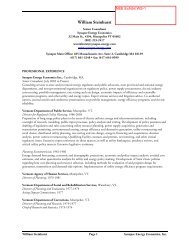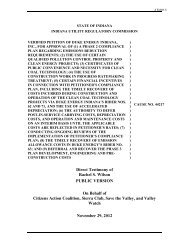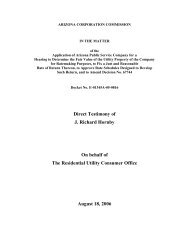Best Practices in Energy Efficiency Program Screening - Synapse ...
Best Practices in Energy Efficiency Program Screening - Synapse ...
Best Practices in Energy Efficiency Program Screening - Synapse ...
You also want an ePaper? Increase the reach of your titles
YUMPU automatically turns print PDFs into web optimized ePapers that Google loves.
theory this approach would produce the most accurate representation of OPIs.<br />
The challenges and uncerta<strong>in</strong>ties of quantify<strong>in</strong>g OPIs are frequently cited as<br />
reasons for not <strong>in</strong>clud<strong>in</strong>g them <strong>in</strong> energy efficiency screen<strong>in</strong>g. We note that these<br />
challenges and uncerta<strong>in</strong>ties exist for many aspects of utility regulation and<br />
plann<strong>in</strong>g, <strong>in</strong>clud<strong>in</strong>g estimates of avoided costs that form the heart of energy<br />
efficiency screen<strong>in</strong>g. Some states have been able to develop quantitative<br />
estimates of OPIs that are sufficiently reliable for plann<strong>in</strong>g purposes. 24<br />
Readily measurable OPIs only: Develop quantitative estimates of those OPIs that<br />
are readily measurable. This is a practical approach because several OPIs are<br />
readily measureable without significant time or f<strong>in</strong>ancial commitments. 25<br />
However, it may fail to capture the full range of OPIs, depend<strong>in</strong>g upon the<br />
resources and time dedicated to the effort.<br />
Sensitivity analysis: Consider cost-effectiveness results with vary<strong>in</strong>g ranges of<br />
OPIs <strong>in</strong>cluded. For example, New York regulators are provided with benefit-cost<br />
ratios that <strong>in</strong>clude a range of OPIs; from zero OPIs, to half of the readily<br />
measurable OPIs, to all of the readily measurable OPIs. This approach assists<br />
regulators <strong>in</strong> understand<strong>in</strong>g the range of effects that OPIs can have on benefitcost<br />
ratios, and may help to address concerns about uncerta<strong>in</strong>ty <strong>in</strong> the OPI<br />
values. However, this method could require a more qualitative analysis, thus<br />
remov<strong>in</strong>g the benefit of a “bright l<strong>in</strong>e” metric afforded by the use of a costeffectiveness<br />
test.<br />
Adder: Apply an adder to the efficiency program benefits to reflect all the OPIs.<br />
The adder would be used to represent the full range of other program benefits<br />
that accrue to customers. Higher adders could be applied to low-<strong>in</strong>come<br />
programs to reflect the higher level of OPIs that are likely to accrue to low<strong>in</strong>come<br />
customers. Adders could be applied at the measure, program, sector, or<br />
portfolio levels. Overall, this is a simplified approach that does not require<br />
extensive evaluation activities. On the other hand it may be seen as too much of<br />
an approximation, and determ<strong>in</strong><strong>in</strong>g an appropriate adder may be difficult.<br />
Reduced Benefit-Cost Ratio Threshold. Apply a lower benefit-cost threshold<br />
than 1.0 to efficiency programs, especially for programs that are expected to<br />
have significant OPIs. This approach has a similar effect as apply<strong>in</strong>g an adder to<br />
account for OPIs; an adder can be converted <strong>in</strong>to a lower threshold and viceversa.<br />
Us<strong>in</strong>g an adder has the benefit of be<strong>in</strong>g more transparent and avoid<strong>in</strong>g<br />
the need to change energy efficiency screen<strong>in</strong>g thresholds or apply different<br />
thresholds for different programs.<br />
Hybrid: A comb<strong>in</strong>ation of the various options could be employed to create a<br />
hybrid approach. For example, a state could <strong>in</strong>clude all readily measurable<br />
OPIs, and use an adder for hard to measure OPIs. As discussed above,<br />
Vermont uses an adder for OPIs <strong>in</strong> addition to readily measurable OPIs, while<br />
Colorado requires an adder but also allows for readily measurable OPIs.<br />
Further, a state could <strong>in</strong>clude readily measurable OPIs, and conduct a sensitivity<br />
analysis for additional OPIs. This approach is most consistent with the nature of<br />
OPIs, whereby some OPIs are easily and readily quantified, while others require<br />
24 See, for example, NMR 2010.<br />
25 For additional <strong>in</strong>formation on methodologies for quantify<strong>in</strong>g OPIs, see SERA 2010 and NMR 2010.<br />
| 38 <strong>Best</strong> <strong>Practices</strong> <strong>in</strong> <strong>Energy</strong> <strong>Efficiency</strong> <strong>Program</strong> Screen<strong>in</strong>g | www.nhpci.org







